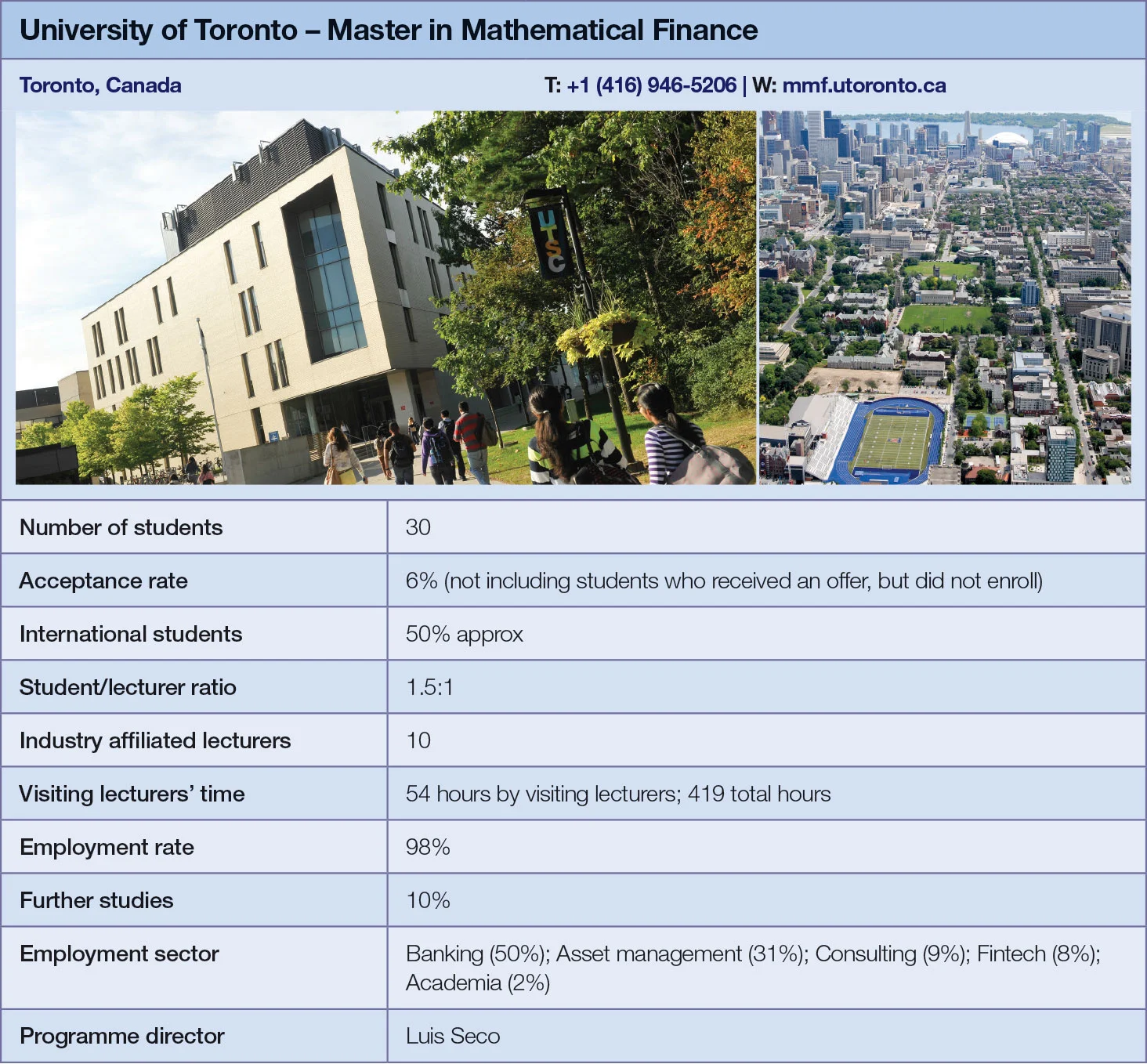
Quant Guide 2017: University of Toronto
Toronto, Canada

Master in Mathematical Finance | metrics table at end of article
Sensitive to the demands of the modern financial industry, the University of Toronto has oriented its mathematical finance programme towards the most pressing issue facing the sector: regulation.
Josie Valotta, programme co-ordinator, says that today bankers find it “impossible to do anything” without national supervisors looking over their shoulders, meaning students need to know the regulatory rule-book inside out to avoid missteps.
“We’re not trying to produce lawyers but we need to produce people who can speak to lawyers. After 2008 and the whole debacle that happened with the subprime crisis, it’s incumbent on every finance professional to be cognisant of what’s happening on that side of the equation, because it’s going to have an impact on what their institution can do,” she says.
To this end, the autumn session includes a module on the modern financial industry complete with guest lectures from industry practitioners and off-campus activities.

Additional modules have been designed “to produce individuals that can go right from the classroom into employment”, Valotta says, informed by feedback received from the programme’s advisory board of academics and industry professionals. Students can choose one of three programme tracks to pursue: risk management, financial engineering and asset management.
“There’s a shift into asset management and data science, regulation and compliance, so we’re trying to tailor the curriculum to reflect those changes,” Valotta says.
There’s also an emphasis on students receiving real-world experience. Each is required to complete a four-month internship in the winter session. Placements are available in Canada, the US and internationally.
“Our internship allows students to take all the work they’ve done in the first term and apply it immediately to real-world problems. We’re driven a lot by the industry,” says Valotta.
On completion of the course, students are required to round off their practical experience by attending two practical workshops – one on risk management and one on energy markets, where they work in small groups on projects in mathematical finance and risk management. The programme also hosts an annual symposium where panellists from different fields of the financial sector come together to discuss industry developments.
Toronto’s programme was founded almost 20 years ago in partnership with IBM, which provided financial support and guidance to the course leaders. Currently around 30 students are admitted to the programme each year, though the university plans to increase its intake in the near future.
Students are expected to start the programme with proven mathematical credentials. Enrollees not only need to be proficient in linear algebra, multivariable calculus, differential equations, real analysis, measure and integration, and probability spaces – they must also have completed at least one undergraduate course in statistics.
Another requirement stressed by the programme administrators is knowledge of computer programming languages, specifically MatLab and C++. Students are also expected to be well briefed on financial and economic fundamentals.
The programme is supported by a number of industry partners, which also recruit from its pool of graduates. These include Deloitte, Deutsche Bank, KPMG, Merrill Lynch Canada, RBC and the Ontario Financing Authority.
Unlike similar courses, Toronto’s programme starts in August. “We found that it can be a bit of a cultural shock for a student who comes from a traditional undergraduate programme, where you start in September and you have time to adjust. When you come to us, you have to hit the ground running,” warns Valotta.

Click here for links to the other universities and an explanation of how to read the metrics tables
Only users who have a paid subscription or are part of a corporate subscription are able to print or copy content.
To access these options, along with all other subscription benefits, please contact info@risk.net or view our subscription options here: http://subscriptions.risk.net/subscribe
You are currently unable to print this content. Please contact info@risk.net to find out more.
You are currently unable to copy this content. Please contact info@risk.net to find out more.
Copyright Infopro Digital Limited. All rights reserved.
You may share this content using our article tools. Printing this content is for the sole use of the Authorised User (named subscriber), as outlined in our terms and conditions - https://www.infopro-insight.com/terms-conditions/insight-subscriptions/
If you would like to purchase additional rights please email info@risk.net
Copyright Infopro Digital Limited. All rights reserved.
You may share this content using our article tools. Copying this content is for the sole use of the Authorised User (named subscriber), as outlined in our terms and conditions - https://www.infopro-insight.com/terms-conditions/insight-subscriptions/
If you would like to purchase additional rights please email info@risk.net
More on Quantitative finance
Quant Finance Master’s Guide 2023
Risk.net’s guide to the world’s leading quant master’s programmes, with the top 25 schools ranked
Baruch topples Princeton in Risk.net’s quant master’s rankings
US schools cement top five dominance as graduate salaries soar
Is it worth doing a quant master’s degree?
UBS’s Gordon Lee – veteran quant and grad student supervisor – asks the hard question
Starting salaries jump for top quant grads
Quant Guide 2022: Goldman’s move to pay postgrads more is pushing up incomes, says programme director
Quant Finance Master’s Guide 2022
Risk.net’s guide to the world’s leading quant master’s programmes, with the top 25 schools ranked
Princeton, Baruch and Berkeley top for quant master’s degrees
Eight of 10 leading schools for quantitative finance programmes are based in US, latest rankings show
Quant grad conveyor belt stalls as banks retrench
Jobs market is long quant graduates, short vacancies – but hiring freeze shows signs of thawing
Quant Finance Master’s Guide 2021
Risk.net’s guide to the world’s leading quant master’s programmes, with the top 25 schools ranked
Most read
- Top 10 operational risks for 2024
- Top 10 op risks: third parties stoke cyber risk
- Japanese megabanks shun internal models as FRTB bites







